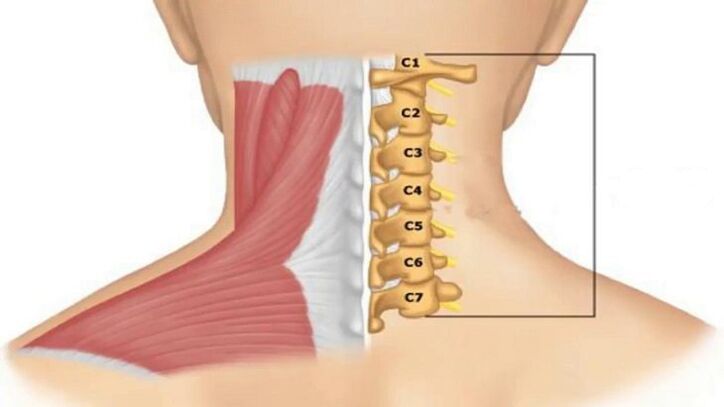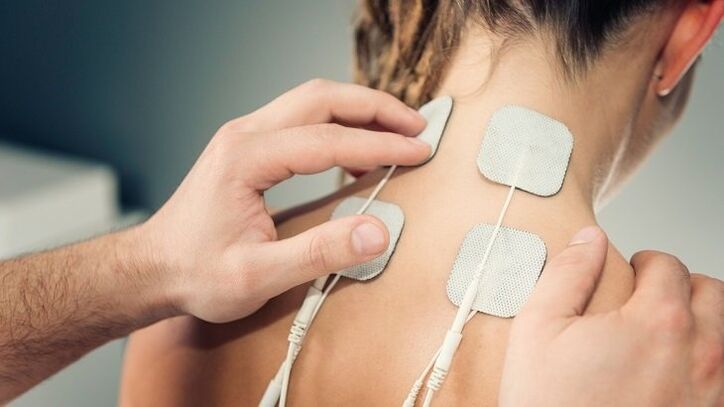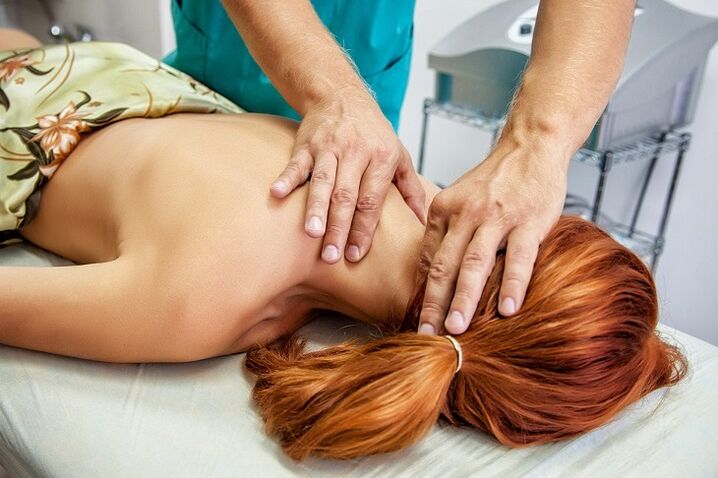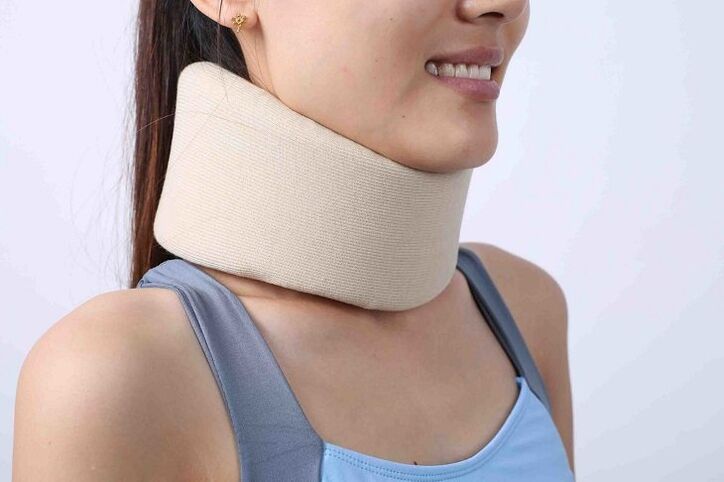Osteochondrosis is a progressive degenerative disease affecting the intervertebral discs. The pathology can appear in any part of the spine, but it most often affects the cervical spine.
The problem cannot be neglected, because over time the symptoms increase, and the pathology itself can lead to serious health problems.

What the
The human spine consists of individual vertebrae, between which there is a special spacer - the intervertebral disc. It is made up of cartilage tissue and acts as a shock absorber, protecting the bone tissue of the vertebra from wear and tear, but at the same time it flattens and wears out.
Usually, such processes take place together with the aging of the human body, and they begin at the earliest after 50-55 years. But every year the pathology becomes younger, premature wear of cartilage tissue has been recorded even in young people (25-30 years old).
The high percentage of osteochondrosis of the cervical spine, compared to, for example, the lumbar spine, is related to the load on this part, which is caused by the need to keep the skull in a vertical position.
The weight of an adult's head can reach 3-5 kg: the mass of the skull bones is about 1400 g, the mass of the brain is about the same, and the mass of the blood circulating in the skull is about 500 g.
The peculiarity of the cervical spine is the closer location of the vertebrae and the smaller thickness of the discs, which leads to complications even in the case of minor changes.
Reasons for development
Factors contributing to the development of pathological changes in the cartilage tissue:
- sedentary lifestyle;
- strained body positions during work (driving, in front of the computer);
- overweight;
- state of nervous tension;
- neck injuries;
- muscle weakness.
The neck muscles try to compensate for the load caused by these factors, which results in their stiffness. Blood circulation, cartilage tissue nutrition and metabolic processes are interrupted, which leads to a change in its structure.
The following also play a role in premature aging of the intervertebral discs:
- hereditary predisposition;
- autoimmune diseases that cause degeneration of cartilage tissue;
- congenital pathologies of the development of the spine.
Stages and symptoms of the development of pathology
Degenerative changes go through several stages, accompanied by specific symptoms:
Section 1. The symptoms are still practically invisible. At this stage, you can stop or slow down the pathological process without drugs (diet, exercise). The patient may feel:
- discomfort in the muscles of the neck and shoulders, their tension, hardness;
- slight pain when turning or tilting the head;
- infrequent and low-intensity headache (most often occurs after static or strenuous work, nervous experiences).
Section 2. The height of the intervertebral discs decreases, compression of the nerve endings occurs, which is why severe pain occurs in the neck, especially during movements and turns. The muscle spasm disrupts the blood supply to the skull, so the symptoms related to vascular insufficiency are also added. The person notices:
- crackling in the joints of the neck when turning the head;
- reduced visual acuity;
- tinnitus;
- dizziness;
- frequent headaches for no apparent reason;
- numbness of the face and neck, loss of sensitivity of the skin of the hands and neck-collar area;
- shooting pains radiating into the scapula;
- sleep disorders.
Section 3. A herniated disc is formed (its nucleus protrudes into the spinal canal), which leads to a malfunction of the nervous system. Symptoms may include:
- numbness of the hands, paralysis of the upper limbs is possible;
- the pain affects the entire neck-collar area and may also radiate to the heart area;
- "floaters" appear in the eyes, nausea and vomiting;
- feeling of a lump in the throat or pain, such as a sore throat;
- the skin of the upper body is not felt at all;
- dizziness occurs with almost any movement;
- the headache is migraine-like.
Section 4. The complete destruction of the disk is characterized by:
- tinnitus can be persistent;
- dizziness may be accompanied by loss of consciousness;
- Coordination disorders occur because the blood supply to the cerebellar region of the brain decreases.

Individual intervertebral discs are extremely rarely affected. The process usually involves the whole class. The destruction of individual disks can be in different stages.
Diagnostics
The diagnosis of cervical osteochondrosis includes instrumental tests and an evaluation of the symptom complex.
Among the instrumental methods, the main information is provided by:
- radiography - shows changes in the structure of the spine, but in the advanced stages of the pathology;
- computed tomography - shows changes in the vertebrae, but intervertebral hernias and compression of the spinal cord are difficult to distinguish;
- magnetic resonance imaging - allows viewing intervertebral hernias and the direction of their growth;
- Ultrasound duplex scan - shows the speed of blood flow in the area of suspected osteochondrosis.
When making a diagnosis, the doctor relies on the syndrome manifested in the patient. A syndrome is a combination of symptoms of a disorder.
In the case of cervical osteochondrosis, the following syndromes may develop:
Spine- indicates that the pathological process affects bone and cartilage tissue. Manifestations:
- limited neck mobility;
- pain when turning the neck;
- structural changes in the vertebra or intervertebral disc (visible on X-ray).
Vertebral artery syndrome– means that the vertebral artery, which supplies blood to the brain, is involved in the pathological process. Main symptoms:
due to lack of blood flow:
- noise in the ears;
- dizziness;
- nausea and vomiting;
- pressure surges;
due to irritation of the nerve endings of the artery:
- severe headache (migraine);
- numbness of the skin on the scalp;
- "floating" in the eye or temporary blindness;
due to oxygen starvation;
- faint;
- lethargy;
- loss of ability to concentrate on anything;
- depression;
- panic attacks.
Heart.Signs similar to cardiovascular problems:
- pain in the sternum (sometimes a burning sensation);
- shortness of breath and fatigue;
- acceleration of heart rate.
Koreshkovy.Depending on the damage to the pair of roots innervating the neck region, nerve impulse conduction disorder:
- 1. -2. root pair - pain or numbness in the back of the head;
- 3rd pair – numbness of the tongue, difficulty chewing food;
- 4th pair – pain in the collarbone, lump in the throat, difficulty swallowing food;
- 5th pair – difficulty moving the arms, the problem is concentrated in the shoulder area;
- 6th pair - discomfort in the shoulder blades and forearms;
- 7th pair - numbness of the hands, more often the middle and index fingers;
- 8th pair - numbness of the ring and little fingers.

Treatment options
Only an integrated approach can be used to treat osteochondrosis. The fight against pathology can take even years.
Drug therapy
The use of drugs for the treatment of cervical osteochondrosis is aimed at:
- relieves pain;
- relieves inflammation and swelling;
- reduces muscle tension in the neck area;
- improves blood circulation;
- protects the cartilage tissue from destruction and promotes its restoration.
To diagnose and treat cervical osteochondrosis, you need to contact a neurologist. If the clinic has a vertebrologist who deals directly with spinal diseases, you can contact him immediately.
Your doctor may prescribe the following medicines:
- Nonsteroidal anti-inflammatory drugs - relieve inflammation and swelling, reduce pain.
- B vitamins - improve the functioning of nerve tissues.
- Chondroprotectors - they protect cartilage tissue from destruction and restore its structure.
- Medicines that improve blood circulation.
- Muscle relaxants are drugs that relieve muscle spasms.
Physiotherapy methods
Physiotherapy methods can quickly alleviate the patient's condition and can be combined with medication:
- Electrophoresis– the affected area is exposed to a low-intensity electric current. It delivers medicinal substances directly to the problem area. It is usually prescribed with an anesthetic to relieve pain or a medicine that improves blood flow to the neck region.
- Ultrasound– has anti-inflammatory properties, improves blood circulation and metabolic processes.
- Magnetotherapy– helps to quickly relieve tissue swelling and improve metabolic processes.
- Laser therapy– helps improve blood circulation at the site of exposure, and also has an anti-inflammatory effect.

Massage
During medication and physiotherapy treatment, it is better to have a specialist massage the neck-collar area.
In the future, self-massage can only be used very carefully, without trying to repeat the depth of effect shown by a professional massage therapist.

During the procedure, the specialist uses classic massage techniques:
- stroking – activates the surface layers of the skin;
- tightening - connects the deep layers of the skin;
- rubbing - warms and relaxes muscles, improves blood circulation;
- kneading - affects very deep tissues, so they are used with caution;
- vibration - tapping and shaking that completes the procedure.
Manual therapy
Sometimes it is recommended to consult a chiropractor in case of cervical osteochondrosis. But this technique causes conflicting opinions: in some cases it certainly helps, in others it almost worsens the situation. The whole point is as follows:
- There is no doubt that a chiropractor must be a highly qualified doctor with a medical degree and training in neurology or orthopedic trauma.
- Manual therapy for cervical osteochondrosis has many contraindications. Two people with similar symptoms may have different answers to the need for manual therapy - one can and should, the other not at all.
Contacting a chiropractor should have strict indications and no contraindications. These are determined by the attending physician and give direction to this type of therapy.
A highly trained chiropractor will not work with a patient without studying the results of the x-ray.
Treatment at home
Traditional treatment recipes or the use of home remedies should be discussed with the doctor in advance, because they can help or worsen the condition in each specific case.
This applies, for example, to the needle applicator used. It consists of plastic spikes attached to a wide band, which you place on the painful area (you can lie on them). Thorns irritate skin receptors and increase local blood circulation. But it cannot be used for infectious and vascular diseases.
It is also popular to heat the affected area with a mustard plaster or a bag of salt or sand. But in the case of vascular diseases, this can be dangerous.
Therapeutic exercise (physiotherapy)
Therapeutic exercises are the safest way to treat cervical osteochondrosis. It is recommended both in the period of exacerbation and in the future - to prevent the disease.
The patient should not feel pain while performing the exercises. If you do it "through pain", not only will it not benefit you, but you can also harm your health.
The simplest but most effective movements are turns, bends and head turns. It is strictly forbidden to do this at high speed and amplitude. Movements should be barely noticeable. Despite such low mobility, the exercise ensures blood flow and improves its circulation in the neck area.
Shants collar
The Shants collar is a rigid head support that relieves tension in the neck muscles and prevents painful movements. It is recommended to be worn both during treatment and to prevent cervical osteochondrosis.
The collar has been worn continuously. The vertebrae are fixed in the correct position and do not exert pressure on each other and on the blood vessels and nerve endings. As a result, pain disappears, blood circulation normalizes, and many symptoms of pathology disappear.

If cervical vertebrae 5-7 are unstable, a bandage cannot be used, as it cannot be fixed in the correct position. Wearing the collar is also not recommended in the case of an enlarged thyroid gland.
Application of an orthopedic pillow
Very often, osteochondrosis is aggravated by compression of the carotid artery and nerve roots while sleeping on an uncomfortable pillow. The orthopedic pillow ensures an even horizontal position of the spine at night.
It does not cure osteochondrosis by itself, but it alleviates the condition and will also be a good tool for preventing the development of degenerative processes in the spine.
Prevention
There are simple rules, the observance of which will help prevent premature aging of the intervertebral discs:
- watch your weight; exceeding the norm by 10 kg causes a critical load on the entire spine;
- try not to lift or carry heavy things;
- if you have to carry a heavy bag, hold it alternately in your right and left hand (or it is better to use a backpack that evenly distributes the load on your entire back);
- every half hour of static work should be replaced with light exercises to relieve muscle tension and improve blood circulation;
- Physical education and sports exercises such as swimming are useful, but running, jumping and lifting weights are harmful to the spine;
- use an orthopedic mattress and pillow for sleeping.
Osteochondrosis of the cervical spine can significantly impair a person's quality of life. The disease can be treated at an early stage, but even when it develops, daily exercise, adherence to the rules of prevention, massage and other measures prescribed by the doctor enable a comfortable life.






















